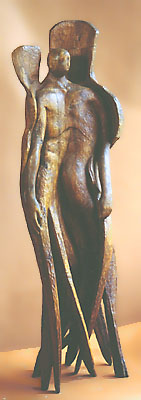|

1928-1991
"Speaking for myself, the rightness between material, form, content, expressive intention and the success of their marriage is what constitutes beauty in art. Moreover, they have to be in divine combination, must radiate a "magic," a "soul," a "spirit" or whatever you wish, to indicate the poetically ineffable. It is the same quality which overwhelms a sensitized observer, changes his or her life and expands experience."
--E.Weinberg
Some artists, obsessed by a personal vision, work a single vein for all it\\\\\\'s worth throughout a whole career, discovering more than anyone had believed possible within that limiting range of material... But there is also another kind of artist, one who is eager to enlarge his idiom so as to cover the widest ranges of experience, to risk new styles and the dangers of experiment, not for the sake of easy adventurism or flashy novelty, but by way of opening himself to large modes of feeling or realms of experience that a mastered but restricted vocabulary would not allow...And if all artists may be divided into these two camps, Elbert Weinberg is firmly in the second."[1]
 After a day of teaching at Boston University, Elbert would often join me [Harold Tovish] and my wife for supper. Later, we would sit around cursing the art world and all its inhabitants, except us three, of course. Warmed up, Elbert would regale us with appalling accounts of a romance gone sour, a wealthy client who owed him money but would not pay up, of people who seemed to exult in their ignorance, and other examples of human foibles.
After a day of teaching at Boston University, Elbert would often join me [Harold Tovish] and my wife for supper. Later, we would sit around cursing the art world and all its inhabitants, except us three, of course. Warmed up, Elbert would regale us with appalling accounts of a romance gone sour, a wealthy client who owed him money but would not pay up, of people who seemed to exult in their ignorance, and other examples of human foibles.
These incidents of "real life" struck him as totally absurd and his stories were accompanied by howls of laughter--his the loudest. After many such evenings it became reasonable to speculate that that the only "reality" that counted for Elbert was what happened in the studio. There, the shaping of events was under his control, and he alone bore the responsibility for the outcome.
He passionately believed in all the old virtues of art: one could not be skillful enough, nor know enough, nor be intellectually or emotionally equal to the task of making a work of art. . .
When he died in 1991, his two studios in Hartford were crammed with four hundred sculptures and nearly a thousand drawings. Add to that the numerous works he sold during his long association with the Grace Borgenicht Gallery in New York. There are the more than two dozen public and private commissions he completed during his career, among which are two of the finest Holocaust Memorials anywhere. His productivity is truly astonishing.Elbert did not develop a "signature style." He was one of the breed that always asks, Is it possible? and then plunges headlong in pursuit of the answer. In the process he produced a body of work that is notable for its variety of content, style, and media. What holds his work together is a Weinbergian exuberance, inventiveness, and masterful execution.
--Harold Tovish [2]
Weinberg was widely recognized among sculptors for his craftsmanship and his predisposition to humanistic themes and forms.
"His talent was just leaking out of him all over the place. We all felt he was the most talented sculptor that we knew," said Charles Perry, a sculptor who met the artist at Yale University and remembers seeing his first Weinberg work in the Metropolitan Museum of Art in New York City as a student. "He was one of the few sculptors who could, out of nowhere, take such a charged, crazy idea, like a dog sitting on a chair barking, and give it such an emotional charge that it actually scared you," he said. "Very few works do that. They always remain the stone or the material." [3]
1. Anthony Hecht, ARTS Magazine, November 1982.
2. Professor Emeritus of Art, Boston University, Retrospective Catalogue, September 1993.
3. Quoted in Hartford Courant, December, 1991.
|
Prix de Rome - 1951-53
Award for Achievement in the Arts - Yale University, 1959
Guggenheim Foundation Award - 1960
American Academy of Arts and Letters Sculpture Award, - 1968
National Academy of Design, Elizabeth H. Watrous Gold Medal for Sculpture - 1989
National Sculpture Society for Lifetime Achievement in Sculpture, Alex Ettl Grant - 1991 Boston Museum of Fine Arts
Brandeis University, Waltham, MA
Colgate University, Hamilton, NY
Dartmouth College, Hanover, NH
Hirschhorn Museum, Washington, DC
Jewish Museum, New York City
Judah Magnes Museum, Berkeley, CA
Museum of Modern Art, New York City
Phillips Academy, Andover, MA
Phoenix Museum of Fine Art, Phoenix, AZ
Rhode Island School of Design Museum
Wadsworth Atheneum, Hartford, CT
Whitney Museum of American Art, New York City
Yale University Museum, New Haven, CT
|

